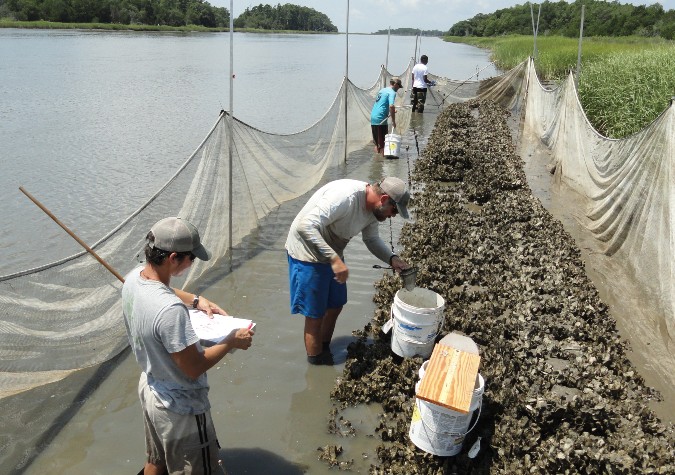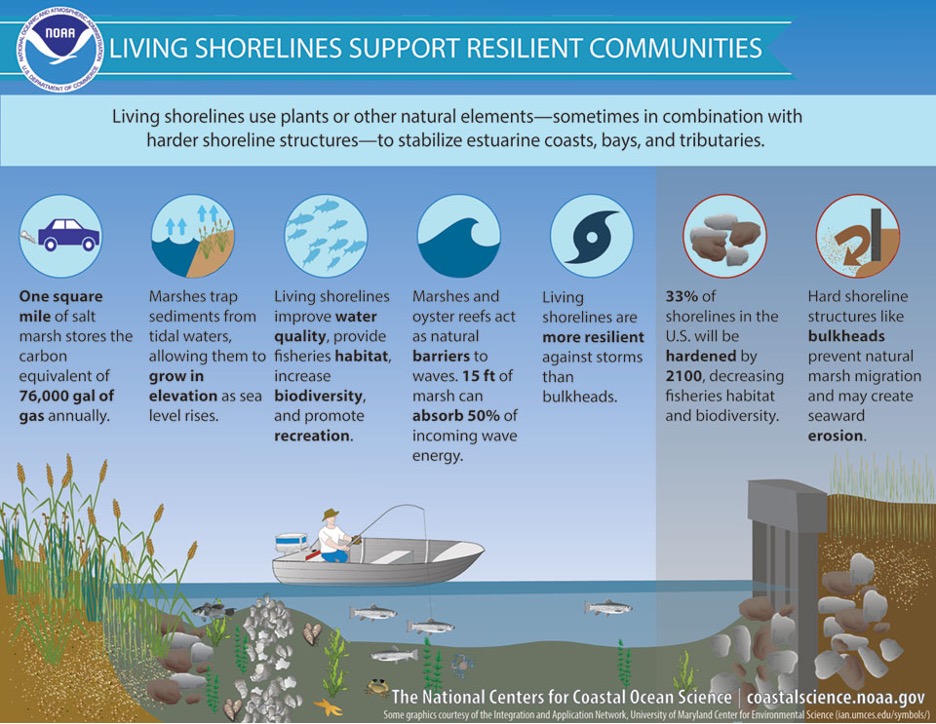Living Shorelines 101

SCDNR biologists monitor the marine life around a living shoreline. Image by Joy Brown, TNC SC
Coastal marsh habitats are at risk due to sea level rise, increased storm intensity, coastline development, and shoreline hardening. Living shorelines are a powerful tool to proactively protect estuarine shorelines. Because of its extensive estuarine shoreline habitat, South Carolina is in an excellent position to take advantage of living shorelines to protect its salt marshes and improve coastal resilience.
-
What is a Living Shoreline?
Living shorelines are a method of stabilizing the shoreline. Living shorelines are encouraged in the estuary as an alternative to traditional hardened erosion control structures such as bulkheads or rip rap. Living shorelines may be placed adjacent to traditional stabilization techniques. Living shoreline methods involve planting of native vegetation and/or the installation of green infrastructure. Green infrastructure consists of materials, such as oyster shell, that promote the health and growth of the native ecosystem and help to maintain the land and water connection.
As of 2021, the South Carolina Coastal Division Regulations (S.C. Code Ann. Regs. 30-1(D)) define a living shoreline as a shoreline stabilization approach utilized in intertidal wetland environments that maintains, restores, and/or enhances natural estuarine processes through the strategic placement of native vegetation and/or use of green infrastructure as described in R.30-12(Q). Living shorelines promote wetland resiliency and water quality and enhance the diverse intertidal habitat.
-
Benefits of Living Shorelines
Living shorelines can protect land from erosion and provide several additional ecosystem benefits. Living shorelines create essential habitat by promoting marsh and oyster growth, buffer boat wakes and wave energy, sequester carbon, and, depending on the materials used, filter pollutants from the water. Natural marshes and those with constructed living shorelines have been shown to offer better shoreline protection than bulkheads during storm events (Gittman et al., 2014). In addition to storm protection, living shorelines that are oyster-based may offer a buffer against the threat of sea level rise. As sea level rises, oyster reef heights will naturally increase; therefore, the reefs persist as natural, growing breakwaters which adjust to the change in tidal elevation (e.g., Rodriguez et al., 2014). These benefits enhance the health and resilience of our coasts while also providing natural protection for property on adjacent uplands.

Living shorelines are used to stabilize shorelines and provide other benefits including habitat, biodiversity, wave barrier, sediment trapping and more. Image courtesy of The National Centers for Coastal Ocean Science.
-
History of Living Shorelines Research in South Carolina
Living shorelines have been a part of the South Carolina Department of Natural Resources’ (SCDNR) coastal management, conservation, and education strategies since the late 1990’s. Constructing living shorelines began as a habitat enhancement tool to increase the amount of oyster reefs and essential fish habitat, but the co-benefits of living shorelines, including shoreline stabilization and salt marsh expansion, can be a great tool for coastal property owners seeking to proactively protect the shoreline and marsh habitat adjacent to their upland private property. Based on property owners’ increasing interest in living shorelines and the benefits to the coastal environment, the South Carolina Department of Environmental Services Bureau of Coastal Management (SCDES BCM) has developed a regulatory definition and project standards for permitting living shorelines in South Carolina. The new regulations, effective May 2021, were developed as part of a five-year strategy and were based on scientific research and stakeholder input. For more information on South Carolina’s living shoreline regulations, please visit SCDES BCM’s Living Shorelines website.
South Carolina living shoreline regulations and project standards were based in part on lessons learned from a multi-year research project designed to evaluate the effectiveness of a variety of greener living shoreline technologies under various environmental conditions in South Carolina. This research, funded by the National Estuarine Research Reserve (NERR) Science Collaborative, was conducted by SC Department of Natural Resources in partnership with the ACE Basin NERR, North Inlet Winyah Bay NERR and SCDHEC OCRM (now SCDES BCM). The project involved monitoring existing living shoreline installations, as well as installing and monitoring new and existing technologies under a range of environmental conditions.
-
Do I need a permit?
SCDES BCM has direct regulatory authority within the estuarine critical areas of South Carolina. Alterations within these areas, including living shoreline installations, require a permit from SCDES BCM. The following steps demonstrate how to obtain these permits:
- A pre-application meeting with SCDES BCM is the first recommended step in the permitting process. For additional permitting guidance, please visit SCDES BCM’s Living Shorelines website.
- In addition to state permitting requirements, additional permits may be required at the local level. It is important to check with your local municipal and county governments regarding additional requirements. In some instances, a permit from the US Army Corps of Engineers may be required.
